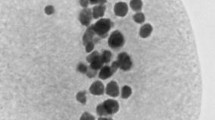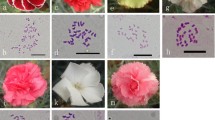Summary
Male sterility in dihaploids ofSolanum tuberosum is often a barrier to their utilization in breeding and genetical studies. Although the male fertility of primary dihaploids (obtained directly from tetraploids) was generally low, a few were produced by the author which produced seed when used as pollen parents on female fertile dihaploids. The population of further generation dihaploids (from dihaploid intercrosses) produced from the showed a marked improvement in male fertility. Comparative data from measurements of different aspects of male fertility in dihaploids are presented. These showed that the weight of pollen per anther, the percentage of (iodine) stainable pollen and the number of seeds per berry were greater in further generation dihaploids than in primary dihaploids.
It is suggested that interspecific crosses using dihaploids are not necessarily useful for increasing male fertility in diploid potatoes. The advantages of breeding at the diploid level withinS. tuberosum are discussed. Rare male-fertile dihaploids could be used to generate diploids with a high frequency of male fertility. These could then be used to cross with any other flowering dihaploids to combine characters at the diploid level, so exploiting the simpler genetic ratios associated with disomic inheritance.
Similar content being viewed by others
References
Bender, K., 1963. Über die Erzeugung und Entstehung dihaploider Pflanzen beiSolanum tuberosum.Zeitschrift für Pflanzenzüchtung 50: 141–166.
Carroll, C.P., 1975. The inheritance and expression of sterility in hybrids of dihaploids and cultivated diploid potatoes.Genetica 45: 149–162.
Carroll, C.P. & R.J. Low, 1976. Aspects of male fertility in group Tuberosum dihaploids.Potato Research 19: 109–121.
Chavez, R.S. & M.H. De Sosa, 1972. Use of dihaploids in the breeding ofSolanum tuberosum L.Hereditas 70: 135–152.
De La Puente, F. & S.J. Peloquin, 1968. Male fertility of selected 24 chromosomeS. tuberosum hybrids.American Potato Journal 45: 436–437.
De, Maine, M.J., 1982. An evaluation of the use of dihaploids and unreduced gametes in breeding for quantitative resistance to potato pathogens.Journal of Agricultural Science, Cambridge 99: 79–83.
De, Maine, M.J., 1988. Berry and seed production using stored pollen of aSolanum phureja clone.Potato Research 31: 385–387.
De, Maine, M.J., 1995. The effects of inbreeding on the parental values of potato dihaploids.Annals of Applied Biology 127: 151–156.
Frandsen, N.O., 1968. Die Plastidenzahl als Merkmal bei der Kartoffel.Theoretical and Applied Genetics 38: 153–167.
Gorea, T., 1970. Fertilität und Kreuzbarkeit der Dihaploiden vonSolanum tuberosum L. und deren F1-Bastarden.Zeitschrift für Pflanzenzüchtung 64: 201–220.
Grun, P., 1970a. Changes of cytoplasmic factors during the evolution of the cultivated potato.Evolution, Lancaster Pa. 24: 188–198.
Grun, P., 1970b. Cytoplasmic sterilities that separate the cultivated potato from its putative diploid ancestors.Evolution, Lancaster Pa. 24: 750–758.
Hermsen, J.G.Th. & J. Verdenius, 1973. Selection forSolanum tuberosum groupPhureja of genotypes combining high frequency haploid induction with homozygosity for embryo spot.Euphytica 22: 244–259.
Hougas, R.W. & S.J. Peloquin, 1960. Crossability ofSolanum tuberosum haploids with diploidSolanum species.European Potato Journal 3: 325–330.
Hutten, R.C.B., W.J.J. Soppe, J.G.Th. Hermsen & E. Jacobsen, 1995. Evaluation of dihaploid populations from potato varieties and breeding lines.Potato Research 38: 77–86.
Peloquin, S.J. & R.W. Hougas, 1960. Genetic variation among haploids of the common potato.American Potato Journal 37: 289–297.
Ross, R.W., S.J. Peloquin & R.W. Hougas, 1964. Fertility of hybrids fromSolanum phureja and haploidS. tuberosum matings.European Potato Journal 7: 81–89.
Suchtelen, N.J. van, 1966. Investigation of dihaploid potatoes in The Netherlands.European Potato Journal 9: 64–68.
Swaminathan, M.S. & H.W. Howard, 1953. The cytology and genetics of the potato (Solanum tuberosum) and related species.Bibliographia Genetica XVI: 1–192.
Author information
Authors and Affiliations
Rights and permissions
About this article
Cite this article
De Maine, M.J. The male fertility of primary and further generation dihaploids ofSolanum tuberosum . Potato Res 40, 59–68 (1997). https://doi.org/10.1007/BF02407562
Accepted:
Issue Date:
DOI: https://doi.org/10.1007/BF02407562




